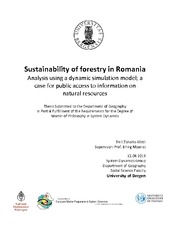Sustainability of forestry in Romania: Analysis using a dynamic simulation model; a case for public access to information on natural resources
Master thesis

Permanent lenke
https://hdl.handle.net/1956/20741Utgivelsesdato
2019-08-30Metadata
Vis full innførselSamlinger
- Department of Geography [634]
Sammendrag
There have been ample studies on the sustainability of Romanian forestry from a qualitative perspective. Quantitative studies on Romania’s forests, however, have focused on either static analysis, or historical analysis. There have been no quantitative studies on the sustainability of Romanian forestry from a natural resource management standpoint. This research addresses the question of whether logging levels in Romania are sustainable, using a quantified dynamic simulation model. The results show that current levels of logging would lead to undesirable outcomes in the future, were they to be held at the same level. It also shows that, the levels of logging determined by actual forestry policies would be both sustainable, and lead to forest volume growth: a desirable outcome considering global carbon sequestration goals. The results indicate that early action to bring logging levels down to the level indicated by policies could have a large positive impact over the course of the next few decades. The relation between the model and the underlying data also showcases the importance of open data access on natural resources. Many parts of the model could be improved with open access to data, and inconsistencies in the data can more easily be brought to light. Solving these inconsistencies is important, as smart policies require an adequate understanding of both the actual state of the forests, as well as the rates of change that affect them.